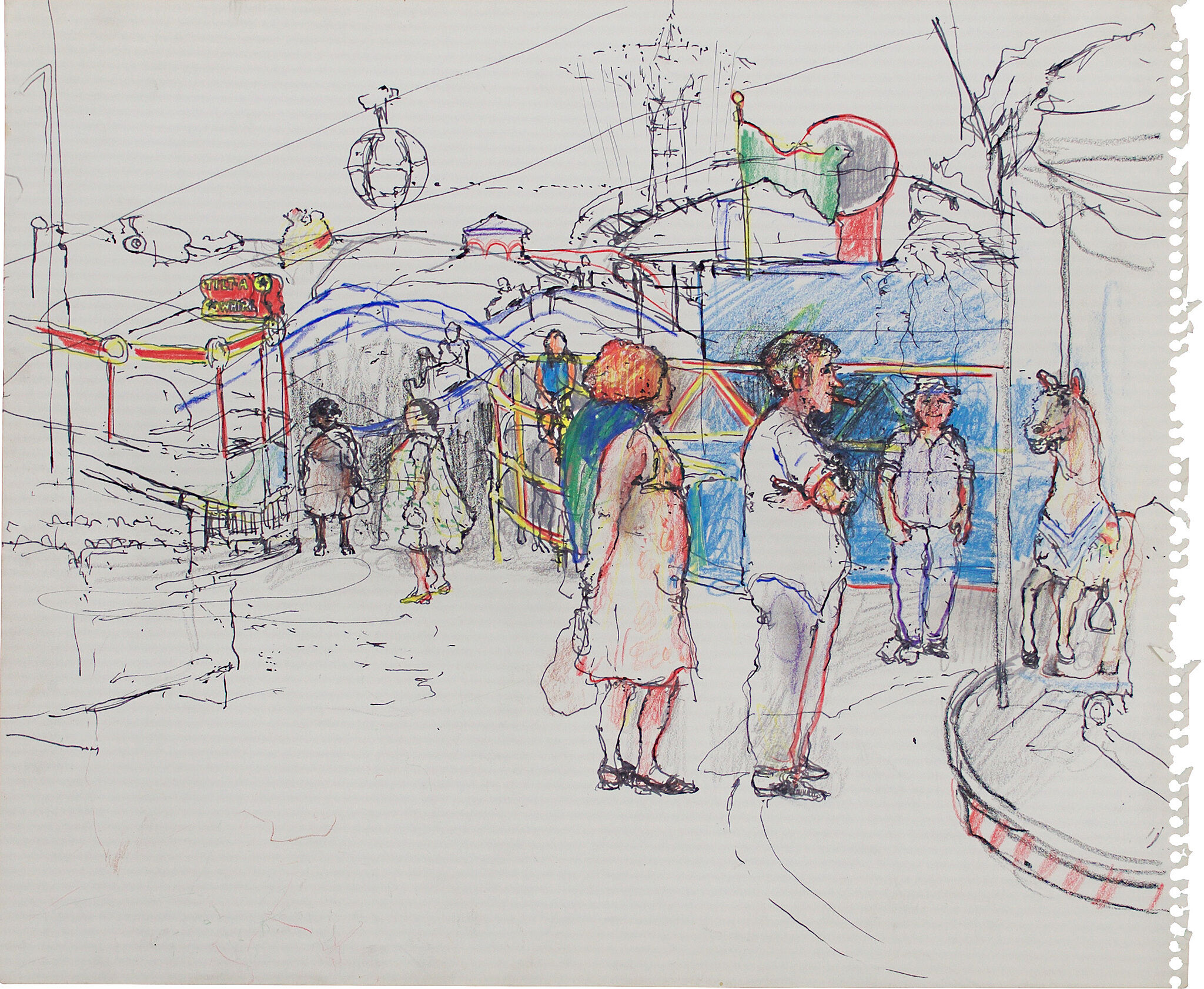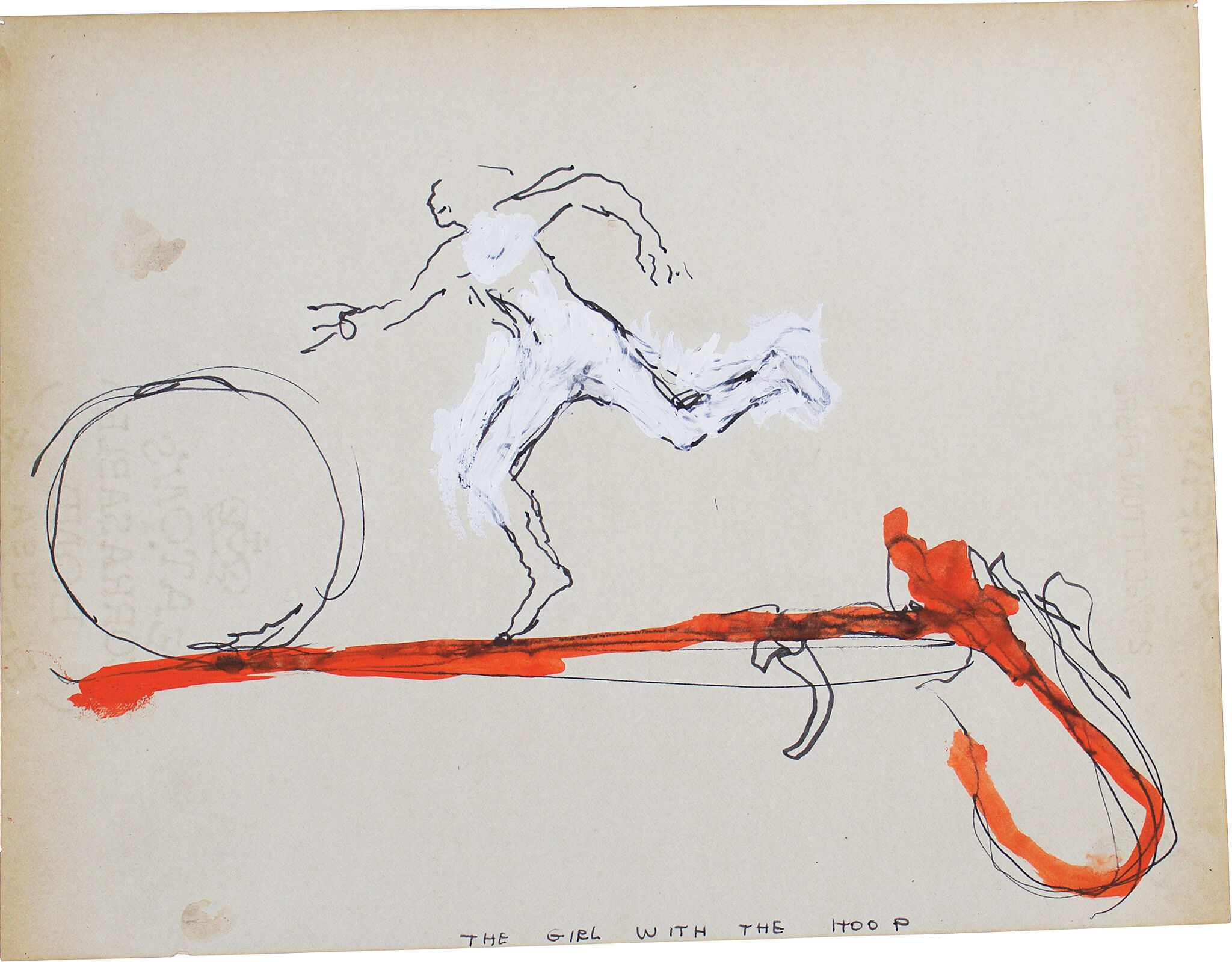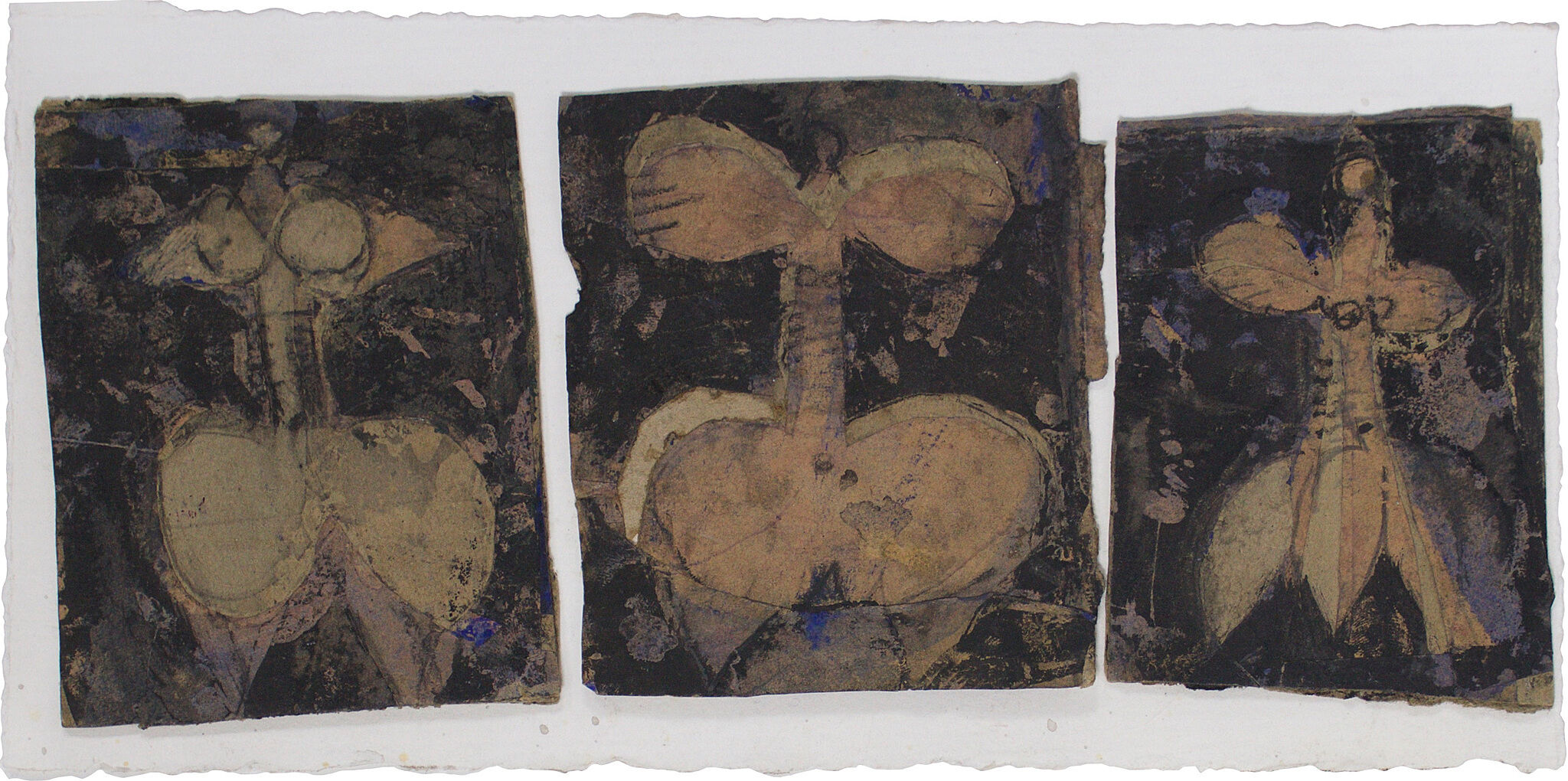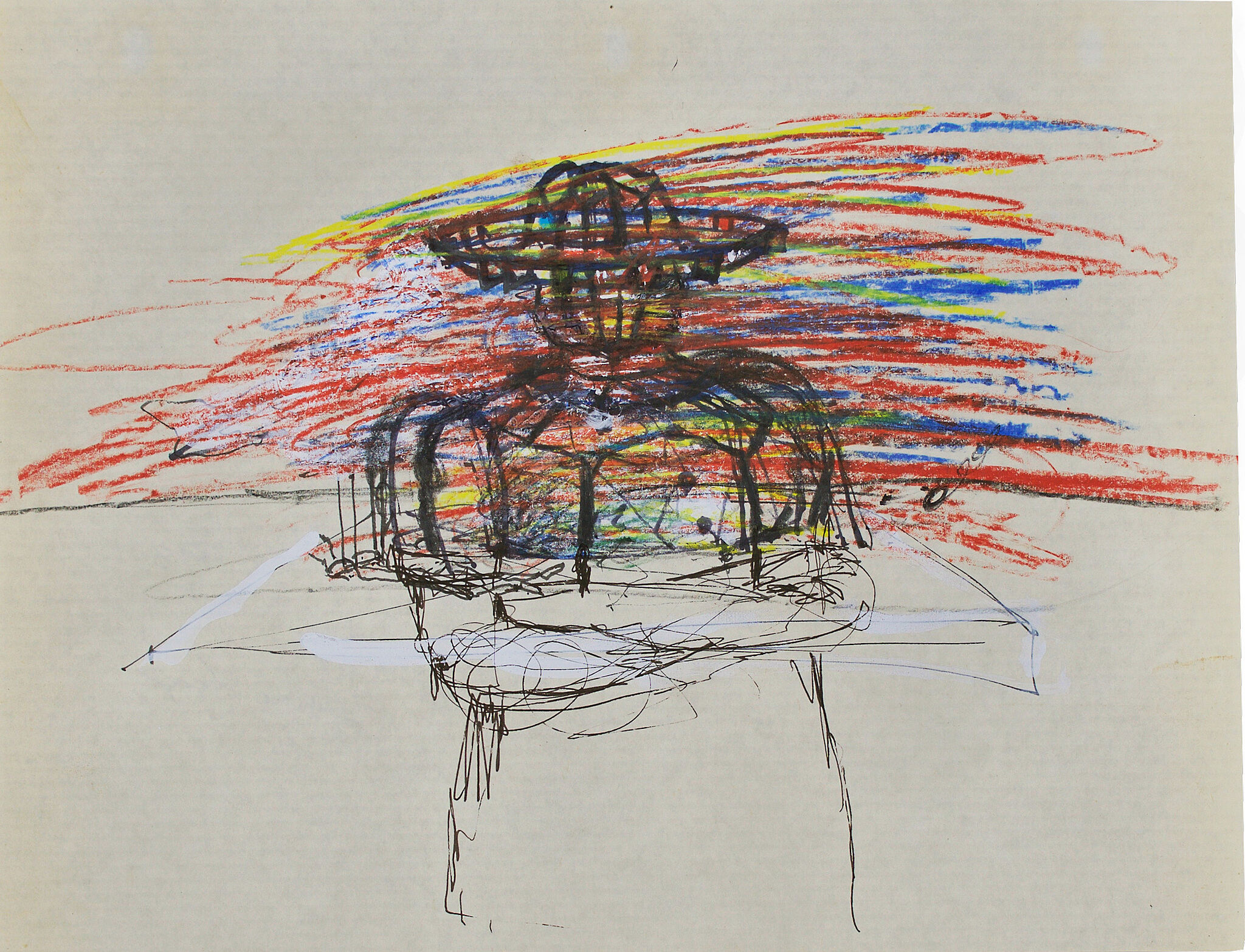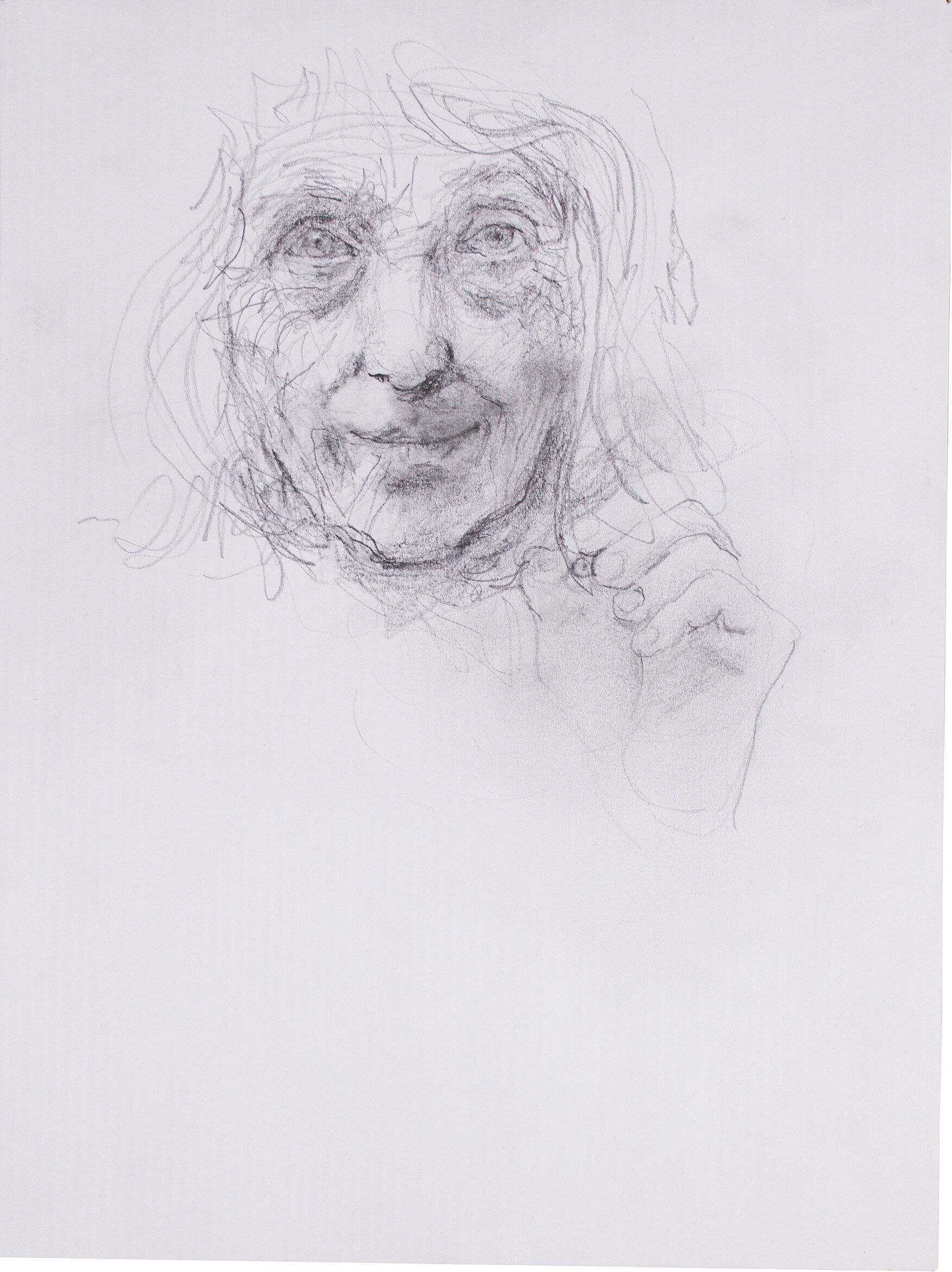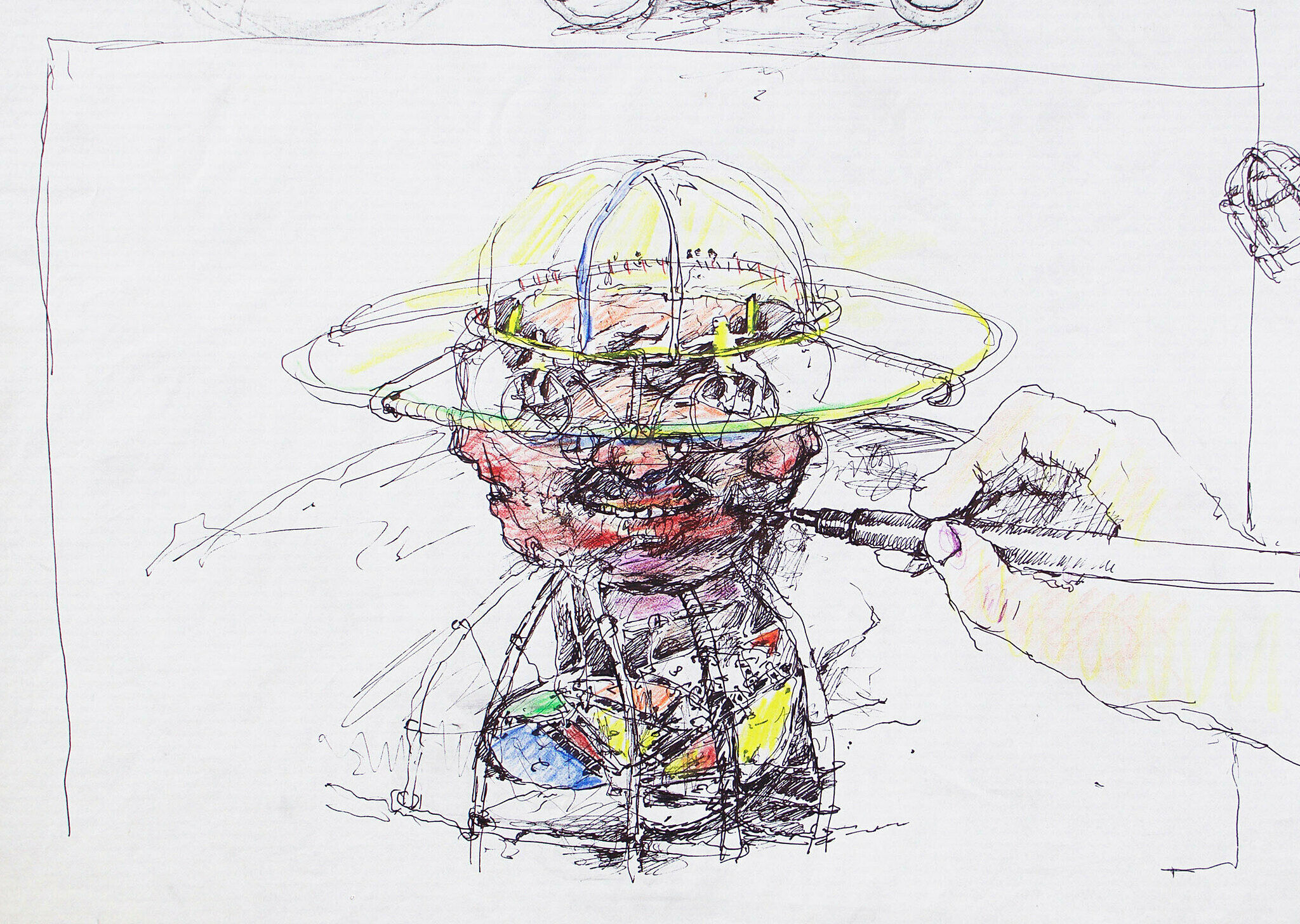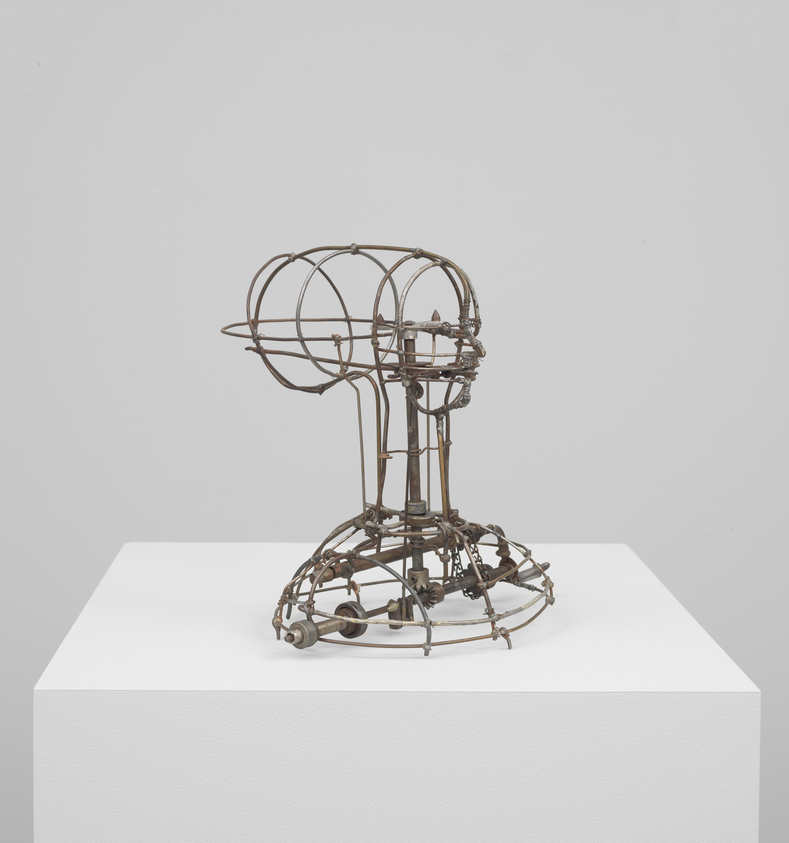June Leaf:
Thought is Infinite
June Leaf: Thought Is Infinite
June Leaf’s 1968 drawing Coney Island (above) is one of her most straightforward images, devoid of the surreal, visionary creatures and places that occupy her creative mind and guide her work. Yet its depiction of a middle-aged couple gazing at an amusement park carousel succinctly encapsulates what her art does: if we envision these protagonists stepping onto the ride, they become an apt metaphor for Leaf’s viewers, who similarly must venture into a deeply imagined realm, grounded in real human experience, in which the artist deploys the fantastic to explore the folly of our existence and the possibilities of consciousness. A more direct expression of this theme occurs in Woman Theater, where Leaf has viscerally enmeshed the imaginary into a human body, making a visual metaphor of the long-standing literary trope of life as theater. In her prolific and rich drawing practice, she makes little distinction among the creative act of the artist, the actual experience of life, and the infinite realm of the imagined. Leaf inscribed “I have discovered that thought is infinite” on a 1975 drawing that explores the same subject visually.
One of Leaf’s most prominent recurring motifs is the hand, implicitly almost always the artist’s own hand, whose role in bringing the imagined into the physical world is crucial. This hand is both a symbol of the act of creation and its literal instrument. She inscribed “It is impossible to do the same story every day” on a sheet whose imagery suggests her own phenomenological embodiment: drawn from the point of view of the artist set up to create, it depicts her hands hovering over her instruments as she gazes onto her immediate surroundings as well as onto the larger world outside the window. More significantly, she shows us the imagined world the artist pulls forth and sets in motion with her hand/mind on the tabletop, as figures come to life and emerge from sheets of paper in front of her. She again lets us inhabit her point of view in Robert Enters the Room, a scene of her longtime studio in Mabou on Cape Breton, Nova Scotia, in which her hands reach out toward the window and the sea beyond. Here we tip on the very brink of the point at which the imagined and the real coalesce, for we are visually on the threshold of the artist’s mind and the physical world, the crux of where things happen for June Leaf. Her embodied hand reappears in Mother/Ballroom, where it hovers above a “sheet” containing a rich rendering of one of her most complex motifs, a gyre-head that appears in numerous works. In this passage, itself part of a larger drawing of multiple motifs, she depicts the separation of the imagined and the actual—her hand part of the latter realm—with the simple drawn square that defines where the art lives: in this case, on a sheet of paper.
Leaf’s small, hand-operated sculptures incorporate the artist’s body directly into the workSee June Leaf, People (Andover, MA: Addison Gallery of American Art, Phillips Academy, 1994).. In these trigger-activated kinetic pieces, an actual hand completes the composition by setting in motion small, cut-metal figures balanced on stiff wires. Photocopies of lost pieces from the series record its subtly shifting variations. Many of the related drawings are, for Leaf, minimal and largely monochromatic—mostly black ink with an economic use of line and form—including a group in which she replaces the gun-like form with a fishing rod from which figures dangle. The scale disparity between hand and miniature human figures posits the artist/creator/controller as omniscient being, another metaphoric exploration of how the imagined takes shape, as the artwork issues from the brain to the hand, which acts as the symbolic and actual bridge between the two.
A relatively simple graphite and ink drawing from 2013 of the artist “threading” her eyes with her fingers finds Leaf literally drawing a line out of her brain/vision. The sheet revisits a motif developed in Threading the Story through the Eye of a Needle from 1974, in which a hand encapsulates an imagined scene seemingly pulled forth—threaded through—the eye of its creator. The hand joins the head explicitly in these images. Leaf’s representations and interpretations of thought as “infinite” seem to be her meditations on imagination’s expression in the physical world through the artist’s corporeality: ruminations on the creative process. The subject of how the mind’s contents become manifest through the artist’s hand is addressed further in a series of works representing substances that issue forth from the brain in various ways. As discussed below, the depth of Leaf’s physicality with materials is paramount to how she creates, so her fascination with how the mind’s contents become manifest through the artist’s hand is a particularly fitting subject for her. In one of her Woman Monument studies, the brain is likened to a pool of liquid that pours from a bowl/head onto the face of its owner, whose hand tilts the bowl forward on an axial pivot, sharing this indeterminate matter whose colors suggest both water and blood. On another sheet, she names this subject directly, inscribing “figure feeling its brain” above an image of her possible alter ego gleefully fingering the sticky, colorful goo of her own mind. Other Woman Monument studies explore striking permutations of the theme: a head has become an overflowing, chalice-like form; a perforated vessel/head spews thin jets of liquid with a pump operated by a hand-cranked set of gears. She treats the idea with delicate intimacy in her close-up of a dreaming, closed-eyed woman who plays a string-figure game with herself and her head. Finally, the artist gives us a raw and visceral spewing brain in her image of a female figure who seems to vomit miniature people into a pitcher from her gaping mouth. In a related sheet depicting another exploding body, a vibrantly colored, teeming mass of angular people seem to eviscerate their female host.
This last example, more focused on the body than on the mind, represents another of Leaf’s overarching themes: transformations and metamorphoses, states of change and becoming, all common narrative and thematic underpinnings in mythology and art history. The two sheets just discussed have parallels with the mutating bodies common in Greek and Roman myths and popularized since the Renaissance through translations of Ovid’s Metamorphoses. Although Leaf is fully aware of such iconographic and art-historical precedents, the artist’s subjects are her own creations; her characters play specific roles in an intensely personal and richly imagined iconography completely dependent on its inventor. The enlightened viewer, however, cannot help but see the archetypes present in her work. One of her earliest repeating motifs (below), at first titled Butterfly Woman, features extravagantly tumescent breasts and buttocks that recall any number of Upper Paleolithic female fertility icons, the most famous of which is the so-called Venus or Woman of Willendorf(Naturhistorisches Museum, Vienna). Common mythological creatures such as unicorns and centaurs appear with some regularity in Leaf’s work, in some cases evoking specific narratives, such as the Education of Achilles, in which the centaur Chiron raises and instructs the young future hero of the Trojan war, who is often depicted riding on Chiron’s back.
When asked, Leaf is happy to reveal what her characters signify in her world, but their meaning is essentially left ambiguous to most viewers. Nevertheless, their formal and typological similarities to well-known stories encourage us to look for parallels in the art-historical past. Her chalkboard piece Handing Over the Infant, for example, evokes biblical stories ranging from the childhood of Moses to the Massacre of the Innocents by King Herod. Throughout her extensive oeuvre we can find amazons, giants, and the sort of hybrid human-animal creatures common to myths and religions all over the world. A recently developed pair of related subjects, Woman Washing Man and Woman Drawing Man, both evoke the biblical story of creation, albeit with genders reversed. Another group of recent works of a hobby horse rider has analogies to Don Quixote, who is frequently depicted on horseback. The associative nature of Leaf’s imagery encourages us to follow her lead and find our own meaning. In this, her closest art-historical kin may be the late nineteenth-century Symbolists, especially Odilon Redon (1840–1916), who also loved to invent fantastic creatures in dreamlike, quasi-formless settings using high-keyed, non-naturalistic colors; both artists intuit a personal universe that hybridizes the traditional with the subjective.
Perhaps the artist’s most original array of archetypes—her own godlike pantheon—are the biomechanical creatures she has invented and explored over the decades. In her kinetic sculptures, Leaf adapts geared devices such as egg beaters and antique treadle sewing machines to serve as platforms for cut sheet-metal figures. In her drawings she can imagine far more elaborate, unrealizable beings and structures. Leaf is fascinated by all things mechanical, as is clear from a quick survey of the tools, instruments, and materials that fill her studios and homes in both New York and Mabou. She uses magnets constantly to test sculptural compositions, to hold drawings on the wall, or even to build small motors. A recent interest, spurred by a new biographyDavid G. McCullough, The Wright Brothers (New York: Simon & Schuster, 2015)., has been the Wright brothers: they built a machine that could fly. Two of Leaf’s very early drawings, in fact, recall the enchanting flying machines famously conceived and drawn by Leonardo da Vinci; in one, Leaf merges a female form with bat-like wings that seem more mechanical than biological. Three decades later, she imagined a mechanical winged creature and suggested that its beating wings symbolize “the heart.”
Various robotic or automaton-like creatures recur in Leaf’s oeuvre. In the late 1970s, the artist worked at the Lippincott fabrication workshop in North Haven, Connecticut, on a large female head with a pronounced and elongated crown, a motif that had appeared much earlier in one of Leaf’s drawings of a group of seated pharaohs. Another sculpture related to the Lippincott commission, The Head, reveals a system of gears and shafts under the open framework “skin.” The Head represented just part of a giant creature with biomechanical interior systems that Leaf described explicitly on a rubbing made from a cut-metal sculpture. This sheet depicts a striding and powerful “Woman of the 20th Century”: “her heart turns in chest like a ‘distributor’ and her hips contain the dinosaur bone crank shaft.”
In her prolific Woman Monument series, Leaf invents a colossus as an ode to female empowerment. This woman/machine takes numerous forms and was inspired simply by the artist’s idea that “women should build a monument for themselves.” In a group of related variations, she melds pipes with human limbs to form elongated bodies, often perforated so that they might spout water like exuberant fountains. Despite the raw and forceful evisceration these works imply, Leaf imparts them with a playfulness and joy in both imagery and execution. The artist described her most complex conception of Woman Monument in a letter to her mother-in-law, written soon after the Lippincott project. She sets the scene near a possibly ruined city, and “the period is all the ages—with ape-like men or women in hooped skirts.” Hordes of humans construct a giant “machine-like” woman whose spinning hat powers a colossal auger that drills into the earth below. A host of drawings render variations of this strange, enchanting creature, some showing the interior systems with great clarity, while others place her in a larger landscape. Still others adopt the language of scientific illustration to render details of the giant auger and large whirring propeller that show the exposed earth in cross-section, revealing the intersection of land and machine and lending an aura of utopian possibility to these extraordinarily ambitious visions.
Leaf’s fundamental interest in metamorphoses and states of becoming as subjects for her art is paralleled in her working process. As imaginary as the worlds she creates are, the artist’s practice is deeply corporeal, firmly rooted in the physicality of the materials and mediums she uses. Leaf has inhabited the same studios in Mabou and New York for several decades, and both spaces are rich in accretions of the years: most surfaces are speckled and splattered with paint and covered with layers of the objects needed both to make art and to live. Although she uses modern materials and tools such as acrylic paint and, for sculpture, drills and blowtorches, an atmosphere of the past—even an era from before the artist’s own birth—pervades Leaf’s working spaces. A patina of age from the structures themselves—their bones and surfaces—is steadily palpable. Leaf’s objects, tools, materials (especially scraps of metal and wire), and actual artworks—paintings, drawings, and sculpture—circulate around her space, accumulating and coalescing in various groupings. They are game for use. If a piece of art is present there, she may reconsider, reconfigure, and change it as she sees fit. All boundaries are fluid, because Leaf does not delineate categories. She may juxtapose and layer multiple works in different mediums on one wall, their surfaces overlapping, as she considers a related subject drawn nearby on a blackboard propped on an easel, or being sculpted on a tabletop. Art materials such as paint and chalk get replenished as necessary, but once something enters her studio, it is partially subsumed into a richly textured arena capable of both sparking Leaf’s imagination and submitting to her control and manipulations.
Leaf works daily, driven by instinct and intuition. She sometimes invents new themes and motifs, but these often arise organically out of older ones, and the array of subjects she has developed over the years remains close and ready for revisiting or adapting. A recent black-and-white piece showing figures in an interior, for example, began with a photograph she took of the shadows cast by one of her older sculptures, which she collaged onto the center of a larger sheet of paper. The composition then evolved around this beginning image. Starting from a single motif, she will see what kind of response it provokes and continue from there. She may work on a piece for months or revisit a work made years before, transporting works as needed from one studio to the other so that the flow of ideas and process is continuous, despite the great distance between her two homes.
June Leaf uses traditional supports for painting and drawing—canvas and paper—but also more unusual surfaces such as sheets of metal, this being one of her primary sculpting materials. She rarely starts with a pristine surface, because objects often inhabit her space over time and develop a life there before becoming part of her art. Thus Leaf’s methods and studio environment account, in some measure, for the rich and complex textures and the extraordinary interplay between medium and support that is a particularly recognizable quality of her drawings. This is one reason why many of them seem to capture and record a moment seized out of a state of flux. Leaf continuously shifts her studio’s contents, and her images, which resolve themselves from this slow, steady flow of materials, seem as though they might dissolve back into it once again. This is especially apparent when watching her create. Some of her pieces—especially the drawings—have the paradoxical quality of feeling both resolved and unfinished. One feels their churning texture in numerous ways. A sheet will pick up a history before she uses it, collecting marks, stains, bends, folds, and the like. In her studio, the continuity between wall, floor, paper, and canvas is striking. She works her surfaces over and over and over, constantly switching materials, scraping back, washing off, wiping down, and building back up again.
Leaf was trained early in life as a ballet dancer, and there is an emphatic physicality to the way she creates. She moves a great deal when she works, so that when her hand makes contact with a surface it is the culmination of a rolling, taut energy, the material deposited with no small measure of concentrated force. When painting or drawing, she tends to work on a vertical surface, attaching the support to a wall or propping it up on an easel. The artist’s combination of acrylic paint with charcoal, chalk, pastel, and other drawing materials is as unusual as it is masterful. Sometimes Leaf works from life; she is a virtuoso at rendering, as a recent self-portrait (above) attests. More often, an idea or image simply strikes her and she explores it, working very quickly and with many small movements of her entire body, coaxing herself on with her voice as she manipulates chalk and then switches to a loaded brush. She often uses her fingers and hands to work the medium directly onto and into the surface. Acrylic suits her because it dries quickly, and she uses it almost sculpturally, creating extraordinarily rich textures well suited for picking up dry and crumbly vine charcoal or colored chalks. As she experiments with an image or figure and then wipes it away to start again, the surface of the piece changes with each effort, building its own material history. She also frequently collages multiple elements or enlarges one sheet by adding another, accreting surfaces in a different way.
All of these qualities of Leaf’s working methods were apparent in her Mabou studio when I visited in the summer of 2015. At the time, she was further developing motifs first explored in the early 1960s in pieces such as Study for Ballroom with Hobby Horses (1963; Museum of Modern Art, New York). The ballroom—as a symbol for the arena of life, as well as a container for an array of archetypal characters—is one of the artist’s most important themes. In recent variations, she has created another type of hobby-horse rider, a fleshy woman riding a tin barrel. This version was at least partly inspired by a tin can, picked up from her studio floor, to which she had fastened a metal rider with magnets. This new rider has become a keen concern lately, explored across several different drawings on paper, a blackboard piece, and a large-scale canvas, all begun in Mabou and continued in New York in the fall and winter of 2015–16. To the blackboard drawing, she added another of her major motifs: a long curving staircase, contextualizing her personae further and creating a potent symbol of a path upwards. She has also explored a new response to her hobby-horse rider: a reaching figure holding a hand mirror; in one rendition he or she teeters precipitously on a tilted chair. As is typical of her practice, each of these versions has fed ideas into the others, the artist working more or less simultaneously on all of them and their layered proximity in the studio a physical reflection of their conceptual overlap, making it clear that for Leaf, everything is interconnected, that all processes are one process.

